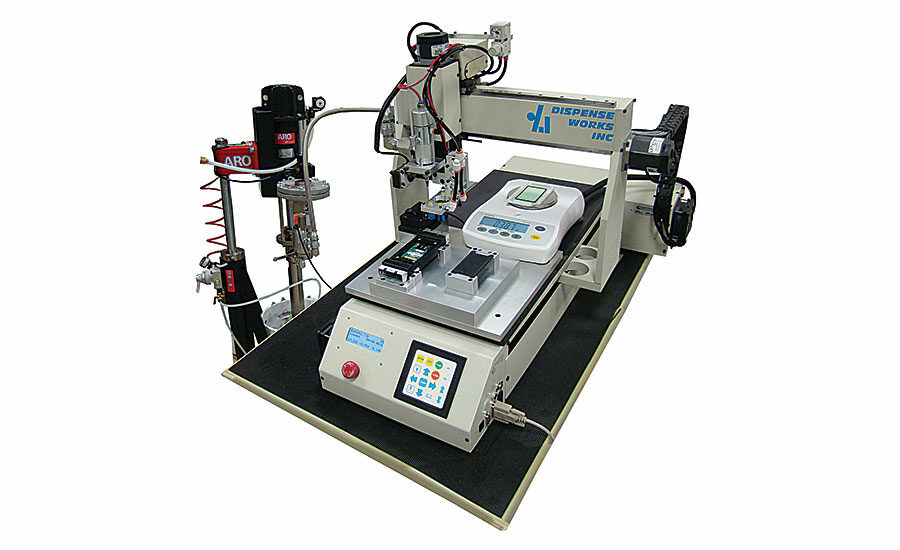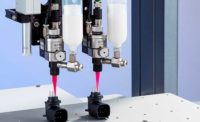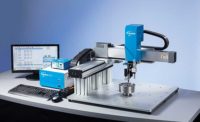It is fair to assert that some technophobes and some manufacturers want to dispense with robots. The difference, however, is the former group wants to do away with them, whereas the latter group wants to do more with them—specifically, benchtop Cartesian and SCARA models. The reason is simple: Robots dispense adhesives and other materials quicker and more accurately than people, with little waste.
Lab technicians at one contract electronics manufacturer know this. For the past two years they have been using a custom benchtop dispensing system from Dispense Works Inc. to quicken assembly of a tiny glass sensor. Previously, three workers separately dispensed tiny amounts of room-temperature vulcanizing silicone from a handheld syringe onto a lead frame and placed a glass sensor (0.0625-inch square) onto the frame.
According to Emil Cindric, president of Dispense Works, the manual process was labor intensive, wasted material and resulted in inconsistent product quality. To eliminate these problems, his company developed a system featuring their benchtop Cartesian robot with specialty tooling mounted on the gantry. Besides dispensing, the tooling performs vision-guided part assembly and testing.
One part of the tooling holds a syringe that moves and dispenses the silicone on the frame. The other part uses vacuum to lift the sensor and place it on the frame. After a couple seconds, the vacuum tool lifts the assembled part and places it on a conveyor. Total cycle time is 3 seconds. Besides ensuring consistent part quality, the system saves the lab $32,000 per week.
Using benchtop robots to dispense materials for assembly is not new. In fact, suppliers have made these machines for more than 30 years. Over the past decade, however, they’ve made benchtop robots easier to use by simplifying the software needed to create dispense patterns. Equally important, they’ve expanded the robots’ capabilities and appeal by providing manufacturers with more feature options.
One Way or Another
When SCARA and Cartesian gantry robots were first developed in the late 1970s and early 1980s, respectively, they were only available in relatively large sizes. Their evolution to benchtop size has come about because of product miniaturization.
Benchtop robots typically have a work envelope from 200 to 1,000 millimeters (about 3 feet) square, but they operate in the same manner as their bigger siblings during the dispensing cycle. After the part is fixtured, the robot arm or gantry (with mounted syringe) moves to the part or parts, dispenses material and returns to its original position.
SCARA robots have four axes of motion. The first two are radial joints in the horizontal plane that allow the arm to swivel about its base and fold in on itself like a folding screen. The third, or Z, axis produces vertical motion, while the fourth axis produces rotational motion around the Z axis.
SCARAs excel in two different applications. One is to lift and transfer the syringe horizontally a short distance and position it just above the part before dispensing material. Another is to transfer the syringe horizontally over a longer distance or an object (like a conveyor) before dispensing. SCARA robots are ideal for these applications because they never tilt the syringe.
The four-axis SR4404 SCARA robot from Nordson EFD covers a 440-millimeter-square work area, and quickly retrieves up to 255 dispensing programs and 30,000 points. Standard features include PC motion control software and a five-phase stepping motor with encoder, which ensures smooth operation. An optional teaching pendant lets the operator create a dispensing sequence without using a PC.
On a Cartesian robot, the mounted syringe moves in straight lines along the X, Y and Z axes. Each axis is a separate linear actuator driven by a ballscrew or belt. Some models rotate the syringe about the Z axis or parallel to it for a fourth axis.
Key benefits of the Cartesian robot for dispensing applications are high-speed accuracy and repeatability, and modularity. Because a Cartesian robot distributes loads evenly across a rigid frame, it accurately and repeatedly dispenses material at high speeds. The robot’s modular construction allows individual axes to be quickly repaired or replaced, and the entire system to be disassembled for use in other motion control applications.
According to suppliers, SCARA robots require less table space than a Cartesian, but do need more headroom. Another difference is work envelope. The SCARA’s is cylindrical, whereas the Cartesian’s is rectangular.
Last year, Fisnar introduced its F7405 Cartesian robot, which has an overall footprint depth of less than 30 inches and a heavy-duty cast base that provides stability and ensures consistent dispensing across the entire 400-millimeter-square work area. The robot moves in five axes: X, Y and Z, as well as rotation and tilt on the Z axis.
“Throughout the 1980s and 1990s, electronics manufacturers were more likely to use SCARA robots for placing circuits and other components on PCBs than dispensing,” notes Karlo Lapasaran, lead project engineer at Fisnar Inc. “When the electronics boom slowed down after Y2K, manufacturers in that industry looked seriously at Cartesian robots for dispensing because of their simpler programming.”
Since then, benchtop Cartesian robots have become popular with electronics manufacturers for a wide range of dispensing applications. They have also found favor with automotive, medical-device, solar-panel and jewelry manufacturers, as well as those in aerospace.
Cindric says medical-device manufacturers use his company’s Cartesian robots to dispense adhesives that bond various tiny parts of a blood pump. In the aerospace industry, one manufacturer uses a custom benchtop robot with onboard vision to orient engraved glass lenses for a military aircraft. After the robot dispenses a special ink that masks the lens’s edging, a pick-and-place head automatically loads it onto a pallet.
“Our goal is to help manufacturers take a mundane task, like manual dispensing, and automate it to ensure dot and bead uniformity,” explains Phil Cohen, national sales manager for Janome IE USA Inc. “Today’s standard benchtop dispensing robots, whether Cartesian or SCARA, make that goal achievable and affordable.”
Material and More
Dispensing methods vary among benchtop robots, although pneumatic time-pressure remains the most popular. In this method, an electronic digital controller applies a measured amount of air pressure, for a measured amount of time, to the back of a disposable syringe (3 to 55 cc), forcing the material out the tip. For applications requiring precision, the dispensing system may use a stepper or servomotor (instead of compressed air) to apply force to a piston that pushes material out of the syringe barrel.
The controller is the key to accurate dispensing, regardless of method. It ensures accuracy by storing settings for specific materials, automatically adjusting settings over time and allowing engineers to lock settings to prevent unnecessary operator adjustment.
Depending on the supplier, a benchtop robot may be purchased with or without an installed dispensing system. This gives the end-user the flexibility to purchase a different system from a third party, rather than accept what’s offered. A good example is when the application requires a system to dispense microliter shots, but the provided system lacks this capability.
Some suppliers, like Techcon Systems, make their own dispensing system and components (pumps, syringes, valves, tips) and require them to be used with their robots. Others only make robots and purchase all their dispensing equipment and components from specialty suppliers.
One medical-device manufacturer uses Techcon’s smallest Cartesian robot, the TSR2201, to dispense cyanoacrylate and bond components used in a portable heart monitor device. The robot replaced three workers who manually applied adhesive beads to 300 parts per day, with a 7- to 10-percent rejection rate.
A TS5622VU diaphragm valve and a TS250 valve controller keep the dispensing system running smoothly, enabling the company to increase production up to 500 parts per day and lower the rejection rate to less than 1 percent. A single operator monitors the robot.
Nearly all benchtop robots feature dispensing systems that handle low- and high-viscosity (1 to 2 million centipoise) materials, including one- and two-part adhesives, cyanoacrylates, UV-curable adhesives, sealants, reagents, conformal coatings, solder paste and lubricants. Applications range from gasketing and potting, to underfilling, bonding and protecting PCBs with conformal coatings.
“For any dispensing application, benchtop robots included, proper valve selection is crucial,” advises Johnathan Titone, product sales representative for Nordson EFD. “A viscous material like solder paste, for example, requires an auger valve, whereas a diaphragm valve is a good choice for low- to medium-viscosity UV adhesives and cyanoacrylates. Needle valves are designed to handle high-viscosity materials such as grease.”
Hot melt adhesive has traditionally not been dispensed by benchtop robots due to long startup times and frequent valve clogging. But, later this month, Techcon Systems will introduce a valve that enables the company’s Cartesian robots to cost-effectively dispense the material.
“Moving from manual dispensing to benchtop robotic dispensing must always make economic sense,” says Ana Maria Grigonis, applications and sales engineer at Fisnar. “Robotic dispensing provides several benefits that, in turn, lower dispensing costs in the short and long run.”
Grigonis says higher throughput, less material waste and rework, and shorter cycle times are most important to manufacturers. They also want repeatable, reliable, precise and error-free dispensing.
Can La, product manager at Techcon, says quicker setup time and greater worker safety are other reasons manufacturers are willing to invest $6,000 to $20,000 for a benchtop dispensing robot. He notes that some manufacturers prefer automated dispensing because it nearly eliminates material handling by workers.
To properly match a robot with one or more applications, a supplier needs to know the size of each part and desired production level. Equally important are the number of dispensing points and patterns per cycle, and type and amount (dot, bead, circle, complex pattern) of materials to be dispensed. Lapasaran says work environment factors—such as ambient temperature, humidity and how the material cures—also need to be addressed.
A New Focus
“Years ago, the main reason manufacturers used benchtop dispensing robots was to cut down on material waste,” says Cohen. “Today, their main focus is making sure the operator can configure and retrieve the dispensing pattern without having to learn complex programming.”
Cohen says that all 15 SCARA robots (single-shaft, double-shaft and clean room) in Janome’s JS series are easy to operate. The robots have arm lengths from 250 to 1,000 millimeters and feature a built-in sequencer that implements up to 100 programs or 1,000 steps. An operator can display measurement units in inches or millimeters on demand.
Easy operation is a key selling point of Cartesian models as well. The three-axis EV series from Nordson EFD comes with vision-guided DispenseMotion software that lets operators quickly create dispense patterns made of dots, lines, circles, arcs or compound arcs. EV models feature a pencil camera to verify product presence and a micro PC equipped with DispenseMotion software that lets the operator control robot movement on any axis.
All three Cartesian robots in Dispense Works’ RP series feature an LCD screen that displays cycle time, batch count, completion percentage and other dispensing parameters in real time. The robots have work areas ranging from 6-by-4 inches to 5-by-12 feet.
Not content with just making benchtop robots easier to operate, suppliers have increased and enhanced the feature options they offer manufacturers. Integrated vision systems, for example, capture and analyze images of parts to ensure that material is properly dispensed.
Other options include bar code scanners (for product verification), light curtains (for worker safety) and fieldbus protocols that simplify automation networking. Techcon even offers a sensing device that adjusts syringe needle height without having to reprogram the dispensing system.





